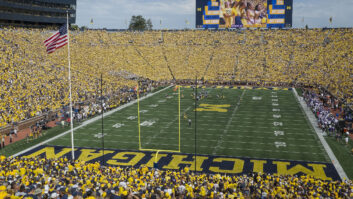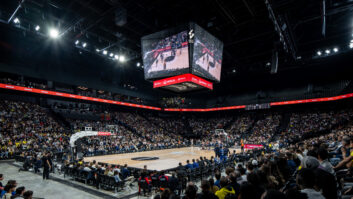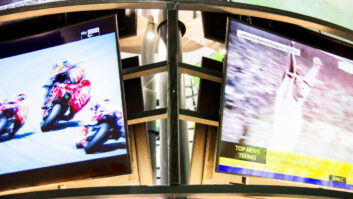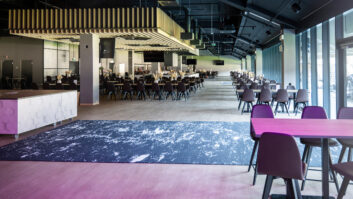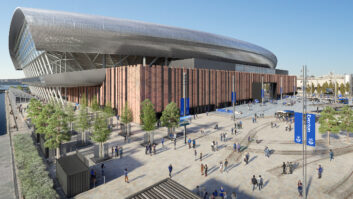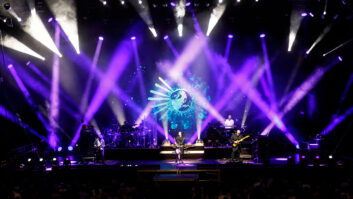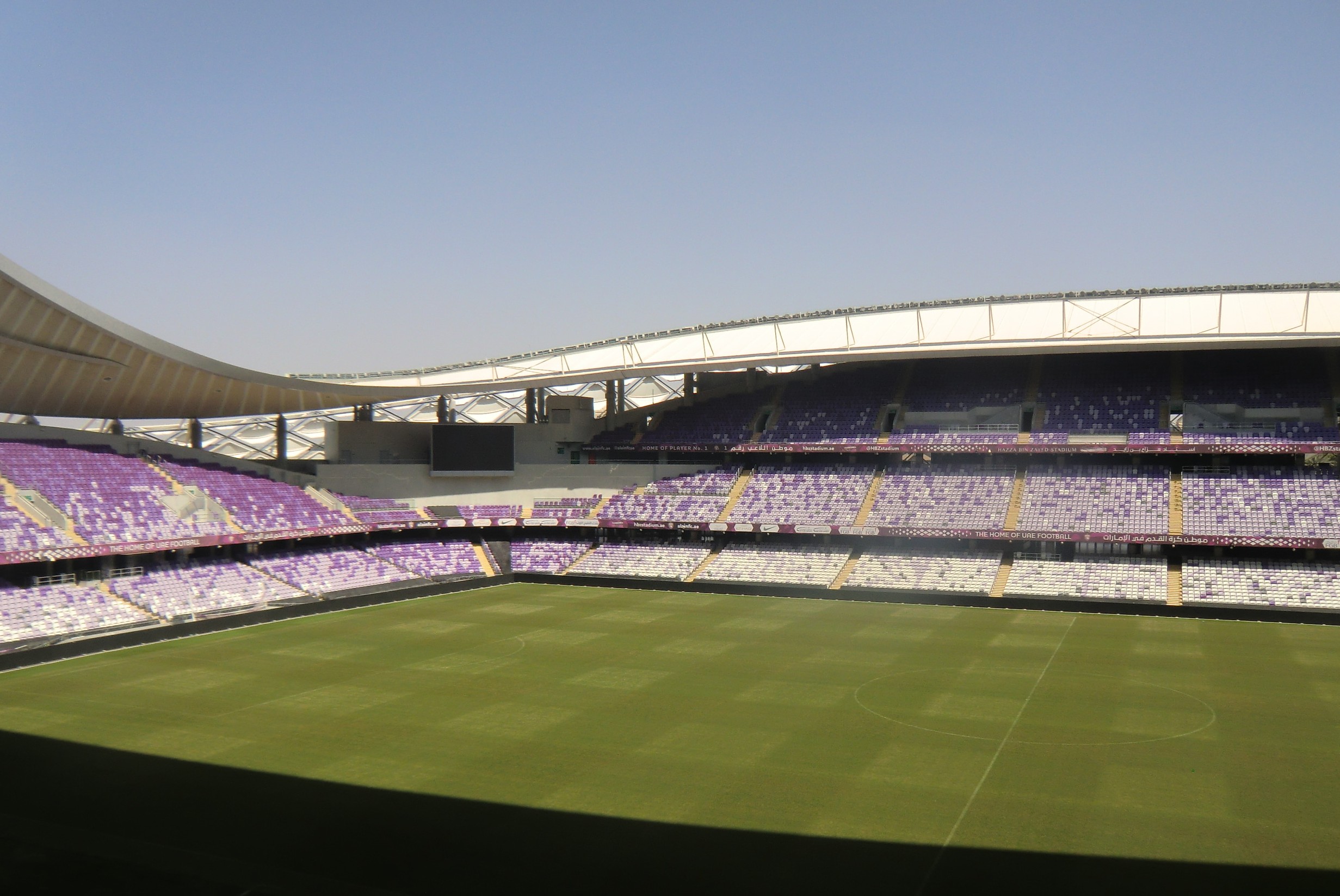
The World Cup is coming to Qatar in 2022, but top-level stadiums are also appearing in other parts of the Middle East. Paddy Baker visited a recent example in Abu Dhabi.
The signs at Hazza Bin Zayed Stadium describe it as ‘the home of UAE football’. The stadium is the first in the United Arab Emirates to be built to FIFA standards. Located in Al Ain in Abu Dhabi, it is the home of Al Ain FC, the most successful team in the UAE Pro-League. Following its opening in January 2014, one of the venue’s more notable fixtures was a friendly between the home team and Manchester City last May.
Architecturally, the stadium features swooping curves, while the façade is covered with angled metallic hexagons, which call to mind the bark of a palm tree. At night the façade can be lit with colours, images or even flags by colour-changing LED lighting.
Hazza Bin Zayed is, according to building services manager David Kaleta, the first stadium to be built under Estidama – an Abu Dhabi-based green building system that is comparable is some ways to LEED, although different in scope.
Energy-saving features at the stadium include a full lighting control system, including the use of occupancy sensors, and solar hot water heating. The main building management system, from Honeywell Alterton, is the central ‘brain’ for most of the facilities management.
Twelve systems
Local integrator JBK Controls was contracted to install 12 different systems: PA/VA, scoreboard, IPTV, room AV, lighting control, broadcast systems, building management system, fire alarm, disabled refuge, stewards’ telephone, master clock system and the central battery system. That’s almost all the low-voltage systems apart from CCTV and access control.
Audio design for the entire stadium was by Roland Hemming of RH Consulting. Under the management of JBK Controls, changes were made to Hemming’s initial design on cost grounds, and were submitted back to him for approval.
The main bowl speakers, installed in the roof line and obscured from sight behind a fine mesh, are from Electro-Voice: overall there are 32 clusters of the manufacturer’s EVF and EVH cabinets. Prosonic, the local Bosch distributor, working in conjunction with the manufacturer’s technical team in Straubing, was also involved in some of the later design work.
For those parts of the seating area that are not covered by the main bowl speakers, fill-in is provided by a ring of E-V Evid speakers.
Outside the main bowl, safety and security announcements are carried via TOA PA speakers. These are driven by TOA VP-2122 and VP-2421 power amplifiers.
TOA’s UAE office, led by Ali Sabri, carried out acoustic modelling for all the numerous areas covered by the manufacturers’ speakers – which includes all of the public areas (apart from the stadium bowl) and includes other parts of the stadium such as VIP lounges and hospitality areas.
A total of approximately 350 TOA speakers have been used throughout the stadium: PJ-304 projection speakers, CS-64 and CS-304 wide-range weatherproof speakers and F-2352C wide-dispersion ceiling speakers.
There are two control rooms in the stadium. On a day-to-day basis, the main control room in the basement is used to manage the CCTV and PA/VA systems. On matchdays, the emphasis moves to the fifth floor control room: this has control positions for PA/VA, CCTV, audio, IPTV and scoreboard systems – as well as an excellent view of the pitch.
Audio mixing is via a Dynacord CMS 2200-3 console which handles all the main audio feeds: stadium audio, including national anthems; live voice announcements; and audio from advertisements played on the main display.
Next to the mixing desk is a TOA paging and fire system, consisting of an RM-200SA remote microphone, two RM-210 mic extension units and an RM-200SF fireman’s mic unit. There are six audio zones in the bowl, 24 in total across the stadium.
Bob Mukherjee, deputy general manager of JBK Controls, explains: “The moment there is a fire situation, an announcement can be made immediately – there is a dry contact into the main audio system. In the same way the access control opens automatically in such a scenario.”
In addition, he says, the CCTV cameras can be used to give security staff visibility of the situation so the best possible guidance instructions can be given for stadium evacuation. “This is possible because audio, access control, fire alarm, CCTV and voice evacuation, all five systems, are integrated – they are all working in tandem,” he says.
Another important life safety element is the disabled refuge alarm system, from Baldwin Boxall. This is deployed across the stadium’s four refuge shafts.
The main display screen is manufactured by Squadrat; because of its exposure to the sun, it is sealed and weatherproofed, with air-conditioning to maintain a constant temperature. It is operated from a PC in the control room, and can also take feeds from the Exterity IPTV system via a fibre link.
High standards
As the first FIFA-standard stadium in the UAE, where, I ask, is this most evident?
“In terms of life safety, and in terms of audio coverage, everything is at a higher level of integration and management,” observes TOA’s Sabri.
(When I talk subsequently to Hemming, he points out that the installed audio system is not fully compliant with the letter of FIFA’s regulations, but few, if any, stadium audio systems are. It does comply with other widely accepted international standards.)
For his part, Mukherjee points to the degree of networking within the stadium, particularly on the video side: “In the OB area, Abu Dhabi Media and other broadcasters come here on match days and connect their equipment. There are also IPTV points along the pitch – broadcasters hook up their cameras to them, and it’s all back-connected.”
There was a high level of scrutiny from the two consultants employed by the main contractor, who, according to Mukherjee, “ran through everything with a fine-tooth comb”. However, he reports, they are now “very happy, down to small details”. Since Installation’s visit, the consultants have upgraded the stadium’s Estidama rating from B to A.
Also, there has been praise from another quarter. Kaleta adds: “Manchester City said it was one of the best stadiums they’ve played in.”
www.baldwinboxall.co.uk
www.dynacord.com
www.electrovoice.com
www.exterity.com
www.jbkcontrols.com
www.rhconsulting.eu
www.squadrat.biz
www.toa.eu
